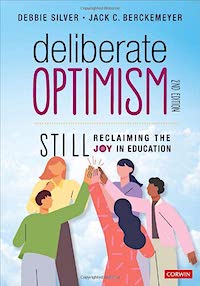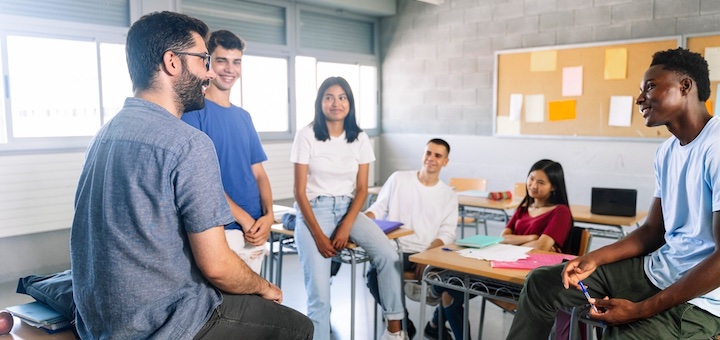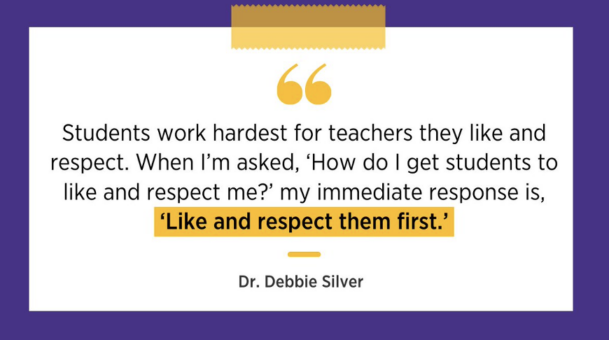Build a Classroom That’s Resilience-Friendly
By Debbie Silver, Ed.D.

No matter what their background or status may be, as they progress through adolescence, they will find themselves facing the fact that life is uncertain.
That’s the sad news. The good news is that students can learn how to pick up the pieces and go on after they face adversity, disappointment, loss, or trauma. They need our guidance to find healthy ways to move forward despite their doubts and fears.
How do we do that? Here are six definitive steps educators can take to create classrooms that foster resiliency in students, distilled from research, my own experience, and the experiences of so many teachers and other education leaders I’ve worked with.
!. Acknowledge and Normalize the Struggle
We must help students understand that life is messy – for everyone! As adults it is our responsibility to be fully present with our students and understand that even though we may want to, we cannot manage their problems for them. Instead of trying to “fix” each situation, we must be willing to listen without judgement, to validate their feelings, and to help them move to a more positive place.
Often when students are overwhelmed, they just want to be heard. My problem as a beginning teacher was that I usually jumped in too quickly to try to solve every personal problem a student brought to me. I would flood them with my eloquent advice, quite sure my expert counsel would turn the tide.
Not so. I finally learned that when kids came to me, they weren’t always asking for a solution – sometimes they just wanted me to listen. It took me a while to realize I needed to clarify what they really wanted. It helped me to find out if they were (1) wanting me just to listen and hear their side of things; (2) to listen and give advice, or (3) to listen and take an action on their behalf. Above all, it was about less talk from me and more listening.
Students generally don’t need us to resolve their situations as much as they need us to help empower them to address and overcome their problems on their own. Letting our students wrestle with everyday disappointments helps them later be better able to deal with the unexpected in strategic ways.
2. Get to Know Our Students
The research is clear that resiliency in students is best fostered in classes where they feel cared about. Students want to be noticed, recognized, nurtured, and valued. Resilience-friendly classrooms are those in which teachers make time to find out about who their students are, what their immediate and distant hopes are, and what strengths they have.
Operating from the vantage point of knowing what is important to their learners, teachers can connect curriculum to student interests and build relationships of trust and respect for every learner. Personal interest surveys, shared journal writing, and ongoing conversations yield important information about who our learners are. Teachers can use these and other means to let students know they matter to us, and they are worth the effort it takes to uncover their strengths and aspirations.
3. Develop Resiliency Through Competency
Sometimes students’ feelings of incompetence lead them to a sense of futility rather than one of success. Having a skilled adult authentically emphasize the student’s areas of strength gives learners a reason to hope as well as the motivation to keep trying. Adults at school can help students develop a self-efficacy that moves their thinking from “I have an insurmountable problem” to “I have strengths I can rely on to get me through this.”
One of the greatest tools I found for helping students who had a defeatist attitude was sitting down with them and asking them to identify the specific difficulties holding them back. I asked them to list all the factors that kept them from achieving their goal(s). Next, I asked them to cross out the factors over which they had no control (i.e. lack of resources, bad prior experiences, lack of inherent talent, etc.).
I explained that we shouldn’t waste our time on things we cannot control, so we need to focus on their remaining list of factors to plan how they could circumvent or overcome their obstacles. Their remaining list helped reinforce the idea they can always control their efforts and their choices. It is important to help students try to do their best (controllable) as opposed to trying to be the best (not controllable).
4. Help Students Connect with Peers
Our classes should act as surrogate tribes to students who have inadequate or no community elsewhere to support them. Creating a safe and caring classroom is done with intention and design. Teachers weave the expected behaviors of acceptance, respect, and civility into their classroom routines and protocols. They establish and enforce the norms of common courtesy.
Teachers purposefully plan lessons that include small group work, and they vary the way groups are assigned. In resilience-friendly classrooms the teacher creates opportunities for students to build relationships, share common experiences, and work together toward mutual goals.
5. Integrate It into the Curriculum
There are countless ways to reinforce the topic of resilience in every classroom. In science class students learn that rubber bands can be acted upon by various outside forces and still retain their fundamental shape (the property of resiliency). What a great metaphor for student toughness!

Source: Astrobites
We can share stories about pioneers in the various fields of science who were told they were wrong or crazy, but they remained focused on their investigations until they ultimately found success. The same is true of mathematicians. We can show and discuss important stories like the women in the movie Hidden Figures.
Students are frequently required to read fiction which often revolves around the central character’s unwavering commitment to their goals despite hardships. In discussions we can highlight how resilience changed the trajectory of the protagonist’s life.
History, too, is full of stories about how major events were shaped by the resilience (or lack of it) from one side or the other. Along that line, coaches can certainly relate the quality of resilience to success in sports just as artists, musicians, and thespians can underscore the importance of tenacity in the arts. Resilience is a social-emotional skill that should be reinforced in all aspects of education.
6. Model It
The teacher should model a visionary rather than victim mentality. We can tell our students about times we felt defeated and/or ready to quit, but we stayed true to our paths. We can share some of the personal struggles we have overcome in our own journeys.
Students usually enjoy hearing us tell stories about times we got embarrassed or made incredibly dumb decisions. Learning to laugh at our own foibles teaches an important lesson about giving ourselves grace. Watching us resolutely deal with our own frustrations and disappointments teaches students effective ways to handle loss, disenchantment, and any number of life lessons.
For some students the adults at school are the most significant role models they encounter. It is more important than ever that teachers build our own self-efficacy so we are better able to demonstrate empathy, resilience, and hope for students. Teachers can have a profound impact on helping students master the lifelong ability to keep moving forward.
For more information on weaving SEL skills into the K-12 curriculum, read Debbie’s book Teaching Kids to Thrive: Essential Skills for Success, reviewed here.

Her other books include Teaching Kids to Thrive: Essential Skills for Success with Dedra Stafford (Corwin, 2017) and Fall Down 7 Times, Get Up 8 (2nd ed.): Raising and Teaching Self-Motivated Learners (Corwin, 2021).
Debbie’s many MiddleWeb articles include the widely read “Empowering Our Kids to Motivate Themselves.” Follow her on X-Twitter and visit her website for more resources and information about her speaking and PD services.







































Great article Debbie! I love the way you connected this struggle with social/emotional learning and curriculum examples.